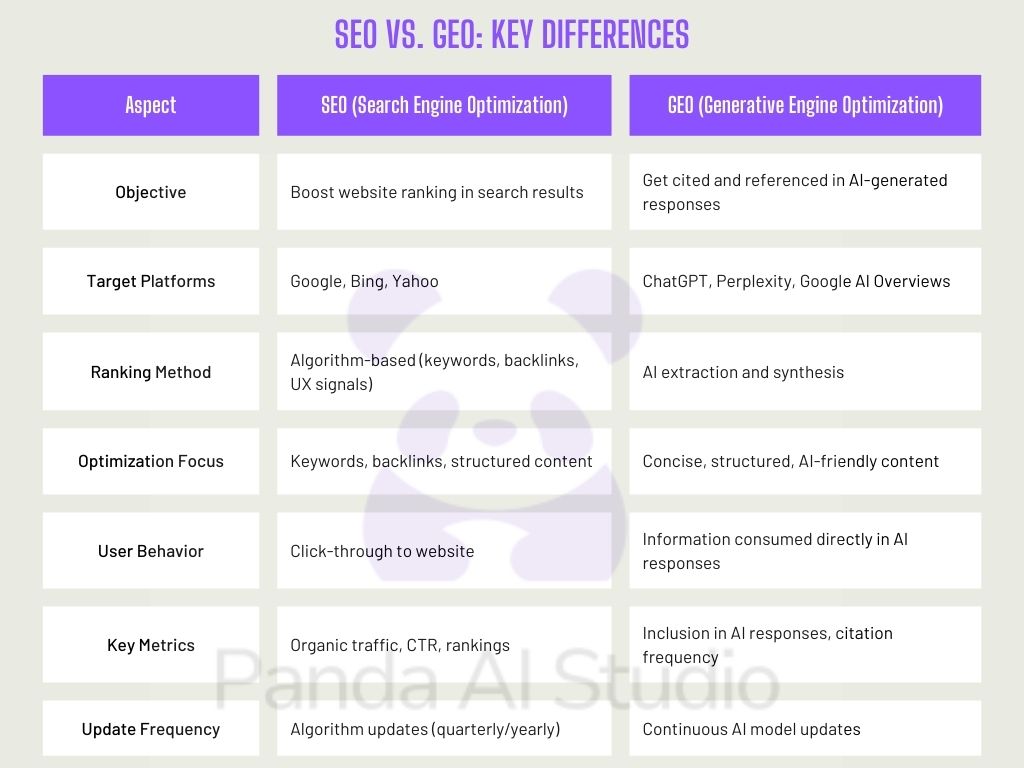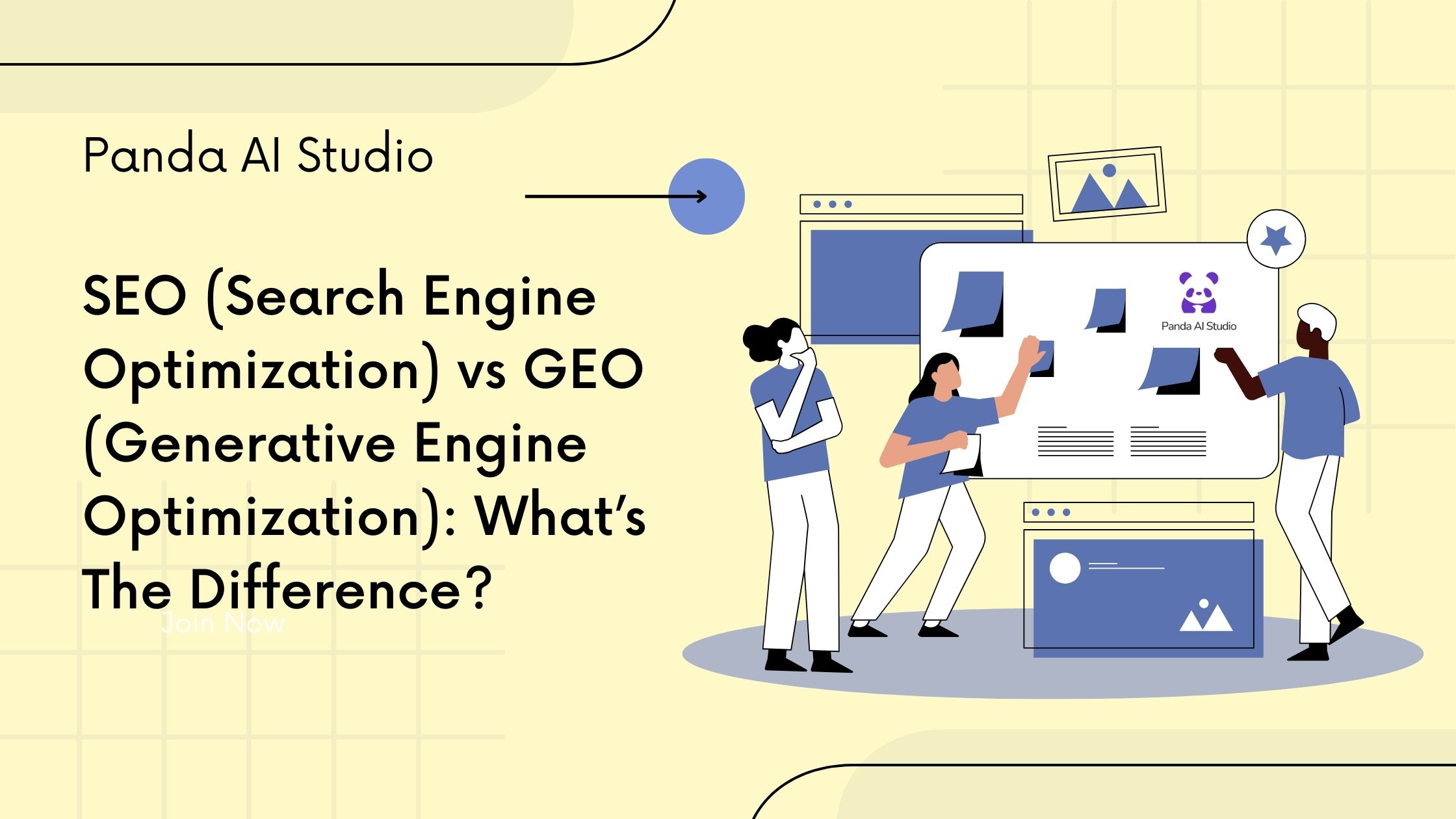Is Your SEO Strategy Still Relevant? Why GEO Is the Future
The battle between Generative Engine Optimization (GEO) vs. Search Engine Optimization (SEO) isn’t just another marketing debate—it’s a game-changing shift already impacting your website traffic, whether you realize it or not.
For years, SEO experts have followed the same playbook: research keywords, craft valuable content, build backlinks, and optimize technical elements to rank higher on Google.
(Who else remembers meticulously tweaking meta descriptions and celebrating every time their site hit the #1 spot?)
But here’s the reality—AI doesn’t search the web the way humans do.
While you’re still optimizing for Google’s traditional search results, millions of potential customers are getting instant answers from ChatGPT, Perplexity, and Google’s AI Overviews—bypassing your carefully optimized website altogether.
Enter Generative Engine Optimization (GEO)—a strategy that ensures your content gets referenced, cited, and featured in AI-generated responses.
The truth? Your competitors who understand this shift are already adapting, while outdated SEO strategies are delivering diminishing returns.
This guide breaks down how GEO differs from SEO, why it matters, and how to optimize for both humans and AI-driven search engines.
- What Is SEO, and What Is GEO?
- SEO vs. GEO: Key Differences
- How SEO and GEO Work Together
- Why GEO Matters for the Future of Digital Marketing
- FAQs: SEO vs. GEO
1. What Is SEO, and What Is GEO?
What is SEO?
Search Engine Optimization (SEO) is the process of improving a website’s visibility in traditional search engines like Google and Bing. The goal is to rank higher in search results, increasing organic traffic.
Core Elements of SEO:
- Keywords: Researching and incorporating search terms that users commonly look up (e.g., “best marketing strategies”).
- Backlinks: Earning links from authoritative sites to boost domain credibility.
- Content Quality: Writing detailed, engaging, and informative content.
- Technical SEO: Enhancing website speed, mobile-friendliness, and proper indexing.
How It Works: Search engines crawl, index, and rank content based on relevance, authority, and user experience.
Example: If you Google “best digital marketing tools,” the top-ranking pages are those optimized with strategic keywords, strong backlinks, and a well-structured layout.
What is GEO?
Generative Engine Optimization (GEO) focuses on optimizing content for AI-powered search tools like ChatGPT, Perplexity, and Google’s AI Overviews. These generative engines don’t return a list of links—they synthesize answers from multiple sources and deliver direct responses.
Core Elements of GEO:
- Clarity: Using concise, AI-readable language.
- Structure: Organizing content with headers, lists, and bullet points to make it easy for AI to extract information.
- Authority: Providing well-researched, credible, and verifiable insights to enhance the chances of AI referencing your content.
How It Works: AI models continuously scan the web, extracting information from structured, high-authority content. GEO ensures that your content is optimized to be selected and cited by these AI systems.
Example: Ask ChatGPT, “What’s the best way to grow a blog?” It might generate a step-by-step answer based on information from a GEO-optimized site, potentially citing the source.
2. SEO vs. GEO: Key Differences
Here is the table providing clear difference between Search Engine Optimization (SEO) vs. Generative Engine Optimization (GEO).

3. How SEO and GEO Work Together
Rather than replacing SEO, GEO complements it. A successful digital strategy incorporates both, ensuring visibility across traditional search engines and AI-driven platforms.
1. Shared Foundation: High-Quality Content
- Comprehensive coverage benefits both SEO rankings and AI extraction.
- E-E-A-T (Expertise, Experience, Authoritativeness, Trustworthiness) boosts credibility for both search algorithms and AI systems.
2. Content Structuring for Dual Optimization
- Headings & Subheadings: Improve readability and enhance AI content extraction.
- FAQ Sections: Serve as SEO-rich snippets and AI-friendly answer formats.
- Structured Data Markup: Helps search engines and AI models better understand your content.
3. Tactical Execution
- Audit existing content for AI readiness.
- Expand keyword research to include natural language queries used in AI interactions.
- Measure both SEO rankings and AI citations to gauge content effectiveness.
4. Actionable Steps for GEO Optimization
- Front-load key information in articles.
- Use direct, fact-based statements AI can easily extract.
- Optimize for entity recognition to increase chances of being cited in AI-generated responses.
4. Why GEO Matters for the Future of Digital Marketing
SEO alone is no longer enough. The future of search is shifting towards AI-generated responses. Adapting your strategy to include GEO ensures your content remains visible, relevant, and influential.
The Bottom Line: Adapt or Become Invisible
The search landscape is evolving rapidly. Businesses that continue relying solely on traditional SEO will struggle, while those who embrace GEO will dominate AI-driven search results.
Rather than choosing between SEO and GEO, integrate both strategies to maximize your online presence.
Where to start? Optimize your top-performing content for AI extraction—improve structure, clarity, and factual accuracy. Monitor your citations in AI responses and iterate based on performance.
Want to make GEO optimization easier? Tools like AI-powered content analyzers can help you optimize faster and smarter.
5. FAQs: SEO vs. GEO
1. What’s the main difference between GEO and SEO?
SEO focuses on ranking in traditional search results, while GEO ensures content is referenced in AI-generated responses. SEO drives website visits; GEO drives AI citations.
2. Is GEO replacing SEO?
No. GEO is enhancing search optimization, not replacing it. Both strategies work together to ensure maximum content visibility across all digital platforms.
3. How does GEO impact SEO practices?
GEO requires structuring content for AI readability, using concise, well-formatted information that AI models can easily extract and cite. It prioritizes clear entity recognition and fact-based statements to increase citation frequency.
4. How can I optimize my content for GEO?
- Use short, clear sentences.
- Format content with bullet points and numbered lists.
- Provide accurate, fact-driven insights.
- Make content easily scannable for AI extraction.
By adopting both SEO and GEO, you future-proof your content strategy and stay ahead in the AI-driven search landscape.


